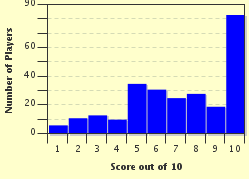Quiz Answer Key and Fun Facts
1. Large parts of Mali are covered by the Sahara Desert and a semi-arid zone called the Sahel. How much of Mali's territory is considered arable land?
2. Since Mali is a landlocked and dry country, its rivers are very important for irrigation and transport. The third-longest river in Africa runs through Mali. What is the name of this river?
3. Mali's population consists of several sub-Saharan ethnic groups, with the exception of two nomadic northern groups. One of those are the Maurs (or Moors); which one is the other?
4. This king of Timbuktu made a pilgrimage to Mecca in 1324 CE. He carried with him 80 camel loads of gold (each carrying between 50 and 300 pounds of gold) to spend along the way, which gave rise to Timbuktu's legend of the city of gold. What's his name?
5. For centuries this city was a northern terminus of the trans-Sahara trade route, and the most important trade partner of Timbuktu. In 1591 CE Al-Mansour, the ruler of this city, attacked and conquered Timbuktu. Which city is this?
6. In the early 1820s many Europeans started looking for the fabled city of Timbuktu. What sparked this sudden interest?
7. During the golden age of the Malian empire, Timbuktu was a renowned centre of learning. What is the name of its most famous university?
8. Another important Malian city is Djenné. It is located halfway on the route between the southern gold mines and Timbuktu, and as a result the history of both cities is closely linked. Nowadays Djenné is more important for tourism than trade. The Great Mosque is Djenné's most famous attraction. The remarkable thing is the material the mosque is made of. What material is this?
9. In the Mopti region, many tourists come to admire a local tribe well-known for its colourful masks and tribal dances. What is the name of this tribe?
10. With the advent of modern transport, the trans-Sahara trade route lost much of its importance. Only one commodity is routinely transported across the desert. Which commodity is this?
Source: Author
AlonsoKing
This quiz was reviewed by FunTrivia editor
Pagiedamon before going online.
Any errors found in FunTrivia content are routinely corrected through our feedback system.

